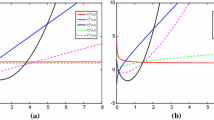Abstract
This paper continues to derive the globally hyperbolic moment model of arbitrary order for the three-dimensional special relativistic Boltzmann equation with the Anderson-Witting collision. The method is the model reduction by the operator projection. Finding an orthogonal basis of the weighted polynomial space is crucial and built on infinite families of the complicate relativistic Grad type orthogonal polynomials depending on a parameter and the real spherical harmonics instead of the irreducible tensors. We study the properties of those functions carefully, including their recurrence relations, their derivatives with respect to the independent variable and parameter, and the zeros of the orthogonal polynomials. Our moment model is proved to be globally hyperbolic and linearly stable. Moreover, the Lorentz-covariance and the quasi-one-dimensional case, the non-relativistic and ultra-relativistic limits are also studied.
Similar content being viewed by others
References
Abramowitz M. Handbook of Mathematical Functions with Formulas, Graphs, and Mathematical Tables. New York: Dover Publications, 1974
Anderson J L. Relativistic Boltzmann theory and the Grad method of moments. In: Relativity. Boston: Springer, 1970, 109–124
Anderson J L. Relativistic Grad polynomials. J Math Phys, 1974, 15: 1116–1119
Anderson J L, Witting H R. A relativistic relaxation-time model for the Boltzmann equation. Physica, 1974, 74: 466–488
Bagland V, Degond P, Lemou M. Moment systems derived from relativistic kinetic equations. J Stat Phys, 2006, 125: 621–659
Cai Z, Fan Y, Li R. Globally hyperbolic regularization of Grad’s moment system in one-dimensional space. Commun Math Sci, 2013, 11: 547–571
Cai Z, Fan Y, Li R. Globally hyperbolic regularization of Grad’s moment system. Comm Pure Appl Math, 2014, 67: 464–518
Cai Z, Fan Y, Li R. A framework on moment model reduction for kinetic equation. SIAM J Appl Math, 2014, 75: 2001–2023
Cai Z, Li R. Numerical regularized moment method of arbitrary order for Boltzmann-BGK equation. SIAM J Sci Comput, 2010, 32: 2875–2907
Cai Z, Li R, Wang Y. Numerical regularized moment method for high Mach number flow. Commun Comput Phys, 2012, 11: 1415–1438
Cercignani C. The Boltzmann Equation and Its Applications. New York: Springer-Verlag, 1988
Cercignani C, Kremer G M. The Relativistic Boltzmann Equation: Theory and Applications. Basel: Birkhäuser, 2002
Chapman S, Cowling T G. The Mathematical Theory of Non-Uniform Gases, 3rd ed. Cambridge: Cambridge University Press, 1991
Denicol G S, Niemi H, Molnár E, et al. Derivation of transient relativistic fluid dynamics from the Boltzmann equation. Phys Rev D, 2012, 85: 114047
Di Y, Fan Y, Li R, et al. Linear stability of hyperbolic moment models for Boltzmann equation. Numer Math Theory Methods Appl, 2017, 10: 255–277
Dreyer W. Maximisation of the entropy in non-equilibrium. J Phys A Math Gen, 1987, 20: 6505–6517
Duan J M, Kuang Y Y, Tang H Z. Model reduction of a two-dimensional kinetic swarming model by operator projections. East Asian J Appl Math, 2018, 8: 151–180
Einstein A. Relativity: The Special and the General Theory. New York: Three Rivers Press, 1995
Fan Y, Koellermeier J, Li J, et al. Model reduction of kinetic equations by operator projection. J Stat Phys, 2016, 162: 457–486
Fan Y W, Li R. Globally hyperbolic moment system by generalized Hermite expansion (in Chinese). Sci Sin Math, 2015, 45: 1635–1676
Grad H. Note on N-dimensional Hermite polynomials. Comm Pure Appl Math, 1949, 2: 325–330
Grad H. On the kinetic theory of rarefied gases. Comm Pure Appl Math, 1949, 2: 331–407
Groot S R D, Leeuwen W A V, Weert C G V. Relativistic Kinetic Theory: Principles and Applications. Amsterdam: North-Holland, 1980
Hiscock W A, Lindblom L. Stability and causality in dissipative relativistic fluids. Ann Physics, 1983, 151: 466–496
Hiscock W A, Lindblom L. Linear plane waves in dissipative relativistic fluids. Phys Rev D, 1987, 35: 3723–3732
Hiscock W A, Lindblom L. Nonlinear pathologies in relativistic heat-conducting fluid theories. Phys Lett A, 1988, 131: 509–513
Hiscock W A, Olson T S. Effects of frame choice on nonlinear dynamics in relativistic heat-conducting fluid theories. Phys Lett A, 1989, 141: 125–130
Israel W, Stewart J M. Thermodynamics of nonstationary and transient effects in a relativistic gas. Phys Lett A, 1976, 58: 213–215
Israel W, Stewart J M. Transient relativistic thermodynamics and kinetic theory. Ann Physics, 1979, 118: 341–372
Israel W, Stewart J M. On transient relativistic thermodynamics and kinetic theory II. Proc R Soc Lond Ser A Math Phys Eng Sci, 1979, 365: 43–52
Jaiswal A. Relativistic third-order dissipative fluid dynamics from kinetic theory. Phys Rev C, 2013, 88: 021903
Koellermeier J, Schaerer R, Torrilhon M. A framework for hyperbolic approximation of kinetic equations using quadrature-based projection methods. Kinet Relat Models, 2014, 7: 531–549
Kranyš M. Kinetic derivation of nonstationary general relativistic thermodynamics. Nuovo Cimento Soc Ital Fis B, 1972, 8: 417–441
Kuang Y Y, Tang H Z. Globally hyperbolic moment model of arbitrary order for one-dimensional special relativistic Boltzmann equation. J Stat Phys, 2017, 167: 1303–1353
Landau L D, Lifshitz E M. Fluid Mechanics, 2nd ed. Oxford: Pergamon Press, 1987
Shen J, Tang T, Wang L. Spectral Methods: Algorithms, Analysis and Applications. Berlin: Springer-Verlag, 2011
Stewart J M. On transient relativistic thermodynamics and kinetic theory. Proc R Soc Lond Ser A Math Phys Eng Sci, 1977, 357: 59–75
Struchtrup H. Projected moments in relativistic kinetic theory. Phys A, 1998, 253: 555–593
Whittaker E T, Watson G N. A Course of Modern Analysis, 4th ed. Cambridge: Cambridge University Press, 1927
Acknowledgements
This work was supported by the Special Project on High-performance Computing under the National Key R&D Program (Grant No. 2016YFB0200603), the Science Challenge Project (Grant No. TZ2016002), the Sino-German Research Group Project (Grant No. GZ 1465) and National Natural Science Foundation of China (Grant Nos. 91630310 and 11421101).
Author information
Authors and Affiliations
Corresponding author
Rights and permissions
About this article
Cite this article
Kuang, Y., Tang, H. Globally hyperbolic moment model of arbitrary order for the three-dimensional special relativistic Boltzmann equation with the Anderson-Witting collision. Sci. China Math. 65, 1029–1064 (2022). https://doi.org/10.1007/s11425-019-1771-7
Received:
Accepted:
Published:
Issue Date:
DOI: https://doi.org/10.1007/s11425-019-1771-7




